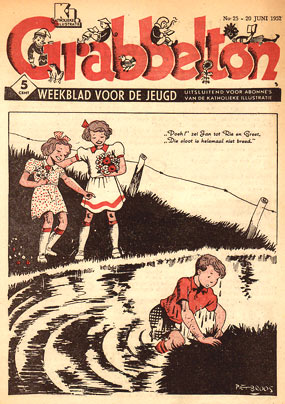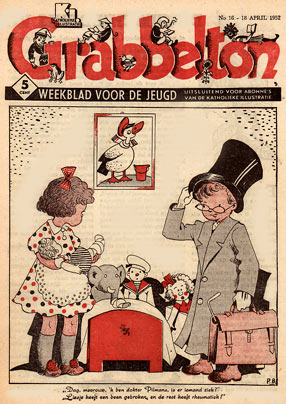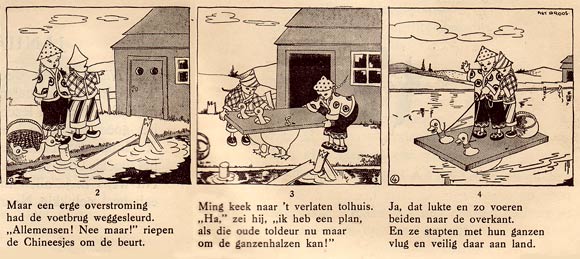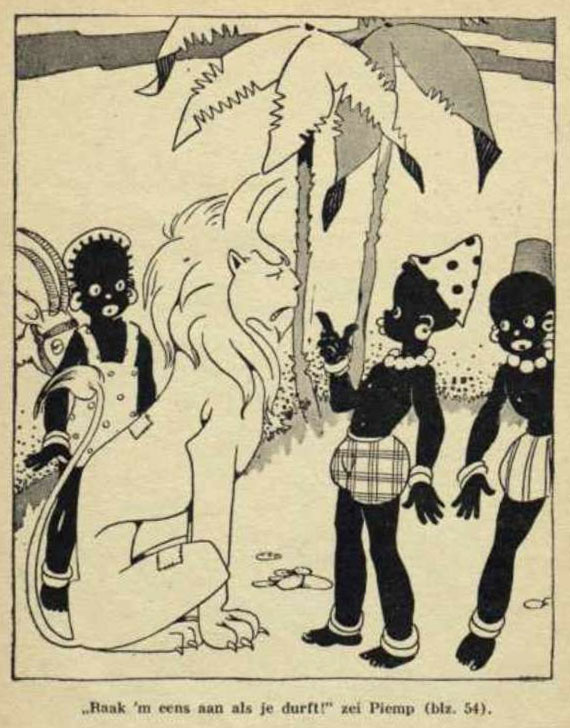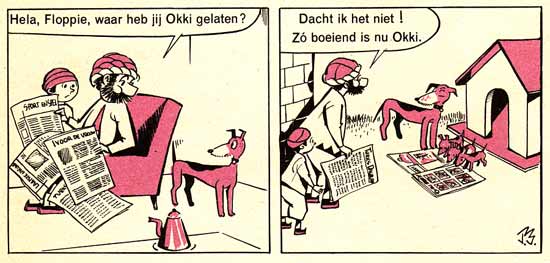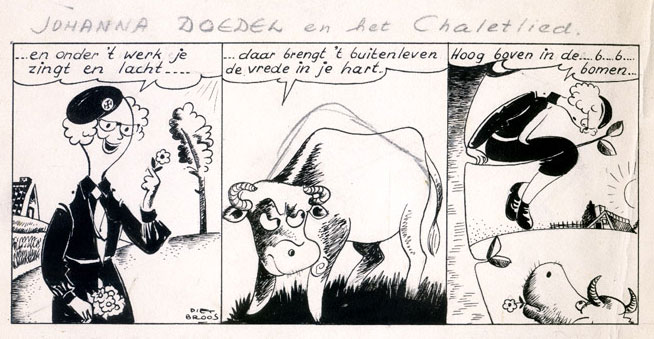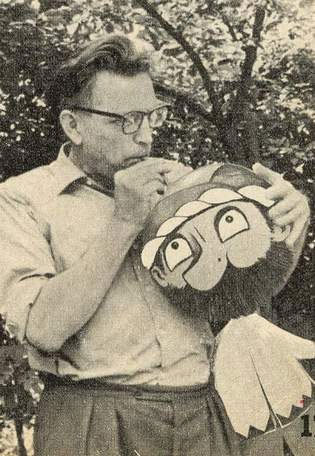First appearance of Jan Pierewiet on 8 June 1946.
Piet Broos was a productive mid 20th-century Dutch illustrator, writer, cartoonist and comic artist, who mostly worked for Roman Catholic publishers. Most of his comics have appeared in Dutch children's magazines (and supplements) like De Engelbewaarder, Sjors, Grabbelton, Kinder-Kompas, Kleuterblaadje, Okki, Taptoe and Onze Krant, as well as the newspapers De Volkskrant, Limburgsch Dagblad and Maas- en Roerbode. His longest-running comic serials were 'Jan Pierewiet' and its spin-offs (1946-1950), 'Avonturen van Brom, Ping en Ming, Slimpie, e.a.' (1948-1964) and 'Ali Baba' (1956-1964). Several later versions of his comic strips were completely reworked or redrawn. In addition, Broos livened up the pages of numerous coloring, picture and children's books, as well as educational books for Catholic schools. He has illustrated over 200 children's books, many of which were also written by him. Some of these have been translated into French, German, English, Spanish, Norwegian, Swedish and Slovakian.
Cover illustrations for Grabbelton, respectively 20 June 1952 and 18 April 1952.
Early life and career
Petrus Jozef Broos was born in 1910 in Zevenbergen, North Brabant, as the son of railway worker Cornelis Broos. He spent a large part of his childhood in Weert, Limburg, where he got his primary school education from the Roman Catholic congregation "Broeders van Maastricht". Broos had his further studies at a small seminary of the Franciscan fathers in Sittard, where his interests in mathematical and linguistic games, adventure stories and devout legends were awakened. Leaving his initial religious calling behind him, he moved with his family to The Hague, where in 1929 he had his first job in the Govers bookshop. After fulfilling his military service, he focused on a career as an illustrator, while taking evening courses from the Academy of Fine Arts in The Hague. He also took the Parisian ABC correspondence course. Among his early clients were the Haarlem-based publishing house De Spaarnestad and the "R.K. Jongensweeshuis van de Fraters van Tilburg", the publishing division of the Boys' orphanage of the Brothers of Tilburg.
Broos' first illustrated children's text story, 'De Droom van een Herder', appeared in the Summer of 1933 in De Spaarnestad's Katholieke Illustratie magazine. Subsequent text stories, often of an edifying nature, appeared in the publisher's children's papers Roomsche Jeugd and Kleuterblaadje, and also in the R.K. Jongensweeshuis publication De Engelbewaarder. Broos additionally worked as a cartoonist for De Humorist (1933-1935) and De Opmarsch (1935-1937).
'Professor Pienterbult' (1939).
Pre-war comics
Outside of the Catholic spectrum, Broos had a long association with Kinder-Kompas, the monthly magazine of the National Life Insurance Bank, which he supplied with tales, stories and drawings from 1938 until his death in 1964. He also made his first comic for this magazine, a text strip starring the Chinese kids 'Ping en Mingie' (1938). Another early comic strip was 'Professor Pienterbult' (1939), which appeared in Roomsche Jeugd. This text comic with silhouette pictures about a clever professor reappeared, either as a reprint or reworked edition, in Doe Mee! (1942), Onze Krant (1948) and the regional Limburg newspaper Maas- en Roerbode (1954). His next comic, 'Knobbeltje Knop' (1939-1941) could be found in De Engelbewaarder and as a reprint in the Flemish magazine Zonneland (1941-1942).
Broos' first book, 'Het Rode Huis' (1938) was published by Helmond. He continued to work for this publisher as an illustrator for picture, coloring and sticker books. It was apparently Broos who came up with the idea to make coloring books with accompanying texts in rhyme. By 1939, he was hired as a part-time advertising illustrator by the Eindhoven-based printing firm Vrijdag.
'Ping en Mingie' (Kinderkompas, 1940).
World War II years
Shortly before the Nazi invasion of the Netherlands, Piet Broos married Cato (Toos) Uijttenhout, after which he was drafted as a sergeant. His battalion saw heavy action during the Battle of the Grebbeberg from 11 to 13 May 1940. After the capitulation and his subsequent captivity, Broos returned to civilian life in December 1940, and tried to pick up his work for De Spaarnestad again. One of his early projects was drawing the adventures of the little boy 'Tommie', which appeared in Okki (1941), the children's supplement of Katholieke Illustratie, and also in Panorama and its supplement Sjors (1941-1942). Despite its use of text balloons, 'Tommie's Avonturen' was mainly a text comic. The story was notable for its subtle hints at the real world. The name of the title hero referred to the nickname for British soldiers, while the boy's adventures took him to Africa where in real life, the British army was fighting general Rommel.
Illustrated books
In 1942, Broos illustrated three books in the series 'Alles In Beeld' for publisher Helmond, namely the titles 'Zilverhoef', 'Jan de Lapper' and 'Prins en Schoonmaker'. The other installments were illustrated by Frans Meijer (AKA Jaap van Loon). Broos and Meijer were also illustrators for Helmond's series of picture book adaptations of literary classics, each with 64 collectable images. Broos illustrated the adaptations of 'Uncle Tom's Cabin' ('De Negerhut van Oom Tom', 1943) and 'Tijl Uilenspiegel' (1943). During World War II, Broos additionally lent his talent to eight illustrated picture booklets in the series 'Het Kleine Prentenboek' ("The Little Picture Book", publisher unknown). Unfortunately, the war-time conditions inflicted a heavy blow to the printing industry, and the artist was eventually out of work. To avoid being sent to Germany for forced labor, he spent the rest of the occupation hiding in a farm in the Peel region.
Post-war comics
When peace returned, on 5 May 1945, Piet Broos changed his familiar style with the deadpan and somewhat bitter picture story book 'Avontuur van Keesje Holland' (1945). Instead of being an innocent children's tale, the story directly referred to the war events in the Netherlands. In the prelude of the Liberation, a little Dutch boy ends up in Africa and becomes a hero by accident after sinking a German warship. The booklet was published by the artist's old client Helmond. Broos then returned to more pleasant children's tales for the annual St. Antonius Almanak. To this publication, issued by SS Franciscus & Antonius in Woerden, he contributed such stories as 'Knoes en Zijn Wonderlijke Avonturen' (1945), 'Professor Snip Snap' (1945-1947), 'De Avonturen van Pinkeltree' (1948) and 'Keesje Slim' (1949).
Between 1946 and 1948, Piet Broos was editor-in-chief for Onze Krant, Helmond's magazine for the Roman Catholic youth. He made three comics for this publication too, namely 'De Daverende Dingen van Daniël' (1946), 'Okkie en Knokkie' (1946) and 'Kuif, De Onverschrokkene' (1948). Broos also returned to the pages of Kinder-kompas with the long-running serial 'Avonturen van Brom, Ping en Ming, Slimpie e.a.' (1948-1964) and the shorter-lived 'Kees en Karel' (1948-1950).
'Avontuur van Ceesje Holland'.
Post-war book illustrations
After World War II, Broos had established himself as a prominent writer and illustrator of children's books, most of them aimed at toddlers. Meulenhoff published his five, by modern standards, very offensive children's books about the "three pitch black negro kids" Piempampoentje, Pompernikkel and Piepeling in their village Klapperdorp: 'Piempampoentje, Pompernikkel en Piepeling' (1945), 'Vacantie in Klapperdorp' (1946), 'De School van Meester Brabbelaar' (1948), 'Nieuwe Avonturen Klapperdorp' (1948) and 'De Grote Reis naar Nederland' (1949). A similar booklet with different characters followed in 1950, 'Pommie, Pruikebol en Pimpernoot'. Picture books like 'Juffrouw Spits op Reis' (1948) and 'Brom Steelt Honing' (1951) were published by Mulder, and Helmond released 'Bartje Pompadoer' (1956) as well as the two books about 'Dikkie Kwik' (1958, 1960). Piet Broos also released one book in English: 'Gnomie Longnose' (1950), published by Sandle Brothers Ltd.
'Piempampoentje, Pompernikkel en Piepeling' (1945).
For Helmond, Broos also undertook another ambitious religious-themed book project by illustrating the children's bible series 'Bijbel Voor De Jeugd' (1946-1948) by Alphons Timmermans. Starting in 1949, Broos wrote and illustrated an 18-part series about the lives of Roman Catholic saints, 'Kleine Boeken van Grote Heiligen'. For the publishing house Malmberg, the artist was responsible for illustrating all 12 volumes of Lea Smulders' 'Pietje Prik' book series (1955, not to be confused with Henri Arnoldus book series about 'Pietje Puk', illustrated by Carol Voges).
When facing death, Jan Pierewiet decides to name his authors "Jef van Lierop from Venlo and P. Broos from Weert" as his heirs (22 April 1948).
Jan Pierewiet
From 1946 until 1956, Broos created many comics for the regional Limburg newspapers Maas- en Roerbode and Limburgsch Dagblad (and possibly also the other papers of the Limburgia Pers). Most notable were the adventures of the wandering musician 'Jan Pierewiet' (18 June 1946 - 1 May 1948), which was, according to the character in the strip itself, made in collaboration with journalist Jef van Lierop. At the end of the original story, Jan Pierewiet had become prince of the Kollenberg. Broos and writer P. van Zevenbergen (a pen name of Broos himself) continued the ongoing narrative with the adventures of Jan Pierewiet's kid son 'Stroppie' (2 June 1948 - 22 February 1950), who becomes the assistant of a professor called Van Krummelen. Along the way, both Stroppie and the professor went missing, as do the detectives who are searching for them. The minister then turns to Jan Pierewiet for help. The prince however doesn't want his whereabouts detailed in the newspaper anymore, and decides to go on his adventure under an assumed name. And so began 'De Avonturen van Toon Okkernoot' (23 February - 15 September 1950).
'Stroppie' (14 September 1949).
The original adventures of 'Jan Pierewiet' had apparently gained such popularity, that in 1947 Limburgia Pers collected them in three booklets. In its farewell article to the original series on 1 May 1948, Limburgsch Dagblad wrote that Jan Pierewiet had become the inspiration for many carnaval outfits in the Limburg region. In the period 1962-1964, a reworked version of 'Jan Pierewiet' was printed in Credo, the weekly of the Diocese Roermond.
Later version of 'Jan Pierewiet', reworked to balloon comic.
When 'Jan Pierewiet' and its spin-offs had come to an end, Broos wrote and drew the animal fable 'Reintje de Vos' (19 September - 8 December 1950), after which Loek van Delden's 'Smidje Verholen' took Broos' spot in the paper. Broos returned in Limburgsch Dagblad with the fairy tale 'Knoest' (26 May 1951 - 8 January 1952). The further newspaper comic strips by Piet Broos presumably only ran in Maas- en Roerbode: 'Kwikkie Kwiek' (1952), 'Slimpie' (1952), 'Poef, het Indiaantje' ("Poef, the Little Indian", 1953), 'Van Kneuteren en Zijn Tonnetje' ("Van Kneuteren and his Little Barrel", 1954) and 'Jan de Lapper' (1956). The latter story was actually a reworking of the 1942 third installment of the 'Alles in Beeld' book series.
'Ali Baba'.
Work during the 1950s and 1960s
During the 1950s and 1960s, Broos also remained a prominent artist in the magazines of De Spaarnestad. After running new Broos stories like 'Jaap, Brom en Annemieke' (1951) and 'Wiebeltje' (1955), the Catholic women's weekly Beatrijs reprinted Broos' earlier newspaper comic 'Reintje De Vos' (1956-1957). The artist illustrated a great many covers for Grabbelton (1950-1954), the children's supplement of Katholieke Illustratie. Between 1955 and 1959, his cartoons and illustrations appeared regularly in Grabbelton's parent magazine. Broos artwork also appeared in Taptoe and Okki, the school titles of De Spaarnestad. These magazines were in fact continuations of Roomsche Jeugd and Kleuterblaadje, for which he had already made stories in the 1930s. For Taptoe, Broos created the one-shot comic 'De Trompetter van De Koning' ("The King's Trumpeter", 1953-1954), reprinted in 1954 in Kalle, the children's supplement of the German edition of the women's weekly Libelle. On its back-pages, Okki printed the artist's second longest-running comic series, 'Ali Baba' (1956-1964).
'Johanna Doedel'.
Other work during this decade includes 'De Blauwvingers van Zwolle' ("The Bluefingers of Zwolle", 1958) and 'Pief Poef, Het Indiaantje' (1960) in Jeugdjuweel, 'Van Twee Pikzwarte Negertjes en Een Rose Speenvarken' ("Of Two Pitch Black Negroes and A Pink Suckling Pig", 1954) in a magazine of the savings bank Bondsspaarbanken, the 'Flip en Flop' series (1958) in Katholieke Missiën, the gag comic 'Johanna Doedel' (1957) in Carillon and eight one-shot stories for Hartentroef (1957-1964). He also made cartoons for newspaper De Volkskrant (1961-1963), while his final new comic strip, 'Abdoel' (1962), ran in the local newspaper De Helmondse Courant.
Death and legacy
In 1964, Piet Broos passed away from heart failure in the village of Weert at the age of 54. Although he was widely recognized as a talented storyteller for toddlers, he put his own career into perspective in his only known interview (1952): "Nonetheless, I believe that a youth book should give: tension, humor, fantasy and many good illustrations. I do my best to bring those, and my children act as readers." A richly illustrated overview book about the author's life and work was written and compiled by his son Kees Broos under the title 'Verteld En Getekend Door Piet Broos (1910-1964)' (Gemeentemuseum Weert, 2004). An exhibition of Piet Broos' work was held under the same title in the local museum of his hometown Weert in 2004-2005. The artist's son Kees Broos (1940-2015) was a renowned Dutch art historian, with a specialization in graphic design and photography.
Piet Broos.




